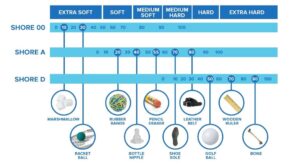Rubber Hardness Measuring
What is Rubber Hardness?
Rubber hardness refers to how firm or soft the material is, which is crucial in determining its resistance to scratching, abrasion, and indentation. It’s a key factor in product design and usually is one of the first properties evaluated when selecting materials, as the desired hardness of the rubber depends on the intended application.
Why Choose Hard Materials?
Harder materials are selected for their high resistance to surface penetration, making them more durable and less susceptible to wear from friction or erosion, especially in environments exposed to steam, oil, and water. This makes them ideal for demanding applications such as caster wheels or heavy-duty construction equipment. For high-pressure and heavy-load situations, hard materials should be prioritized. Conversely, softer compounds are better suited for gaskets and O-rings due to their ability to stretch easily and seal effectively on rough surfaces, thanks to their high elasticity. Gaskets need to be soft enough to fully occupy the gap between two surfaces while also being durable enough to withstand lateral forces. The hardness of rubber is a key indicator of the material’s rigidity and its resistance to bending.
Measuring Material Hardness
Material hardness can be measured in three ways:
- Indentation Hardness: Material's resistance to localized plastic deformation.
- Scratch Hardness: Ability to resist surface scratches.
- Rebound/Dynamic Hardness: Measures the elastic response of the material, indicating how much energy is absorbed and then returned after an impact. Thanks to the elasticity of rubber, the material returns to its original shape without any permanent deformation.
Various tests are used to measure hardness, with results expressed on scales such as Brinell (HB), Rockwell Hardness, Leeb hardness value or Vickers Hardness (HV). For elastomers, hardness is typically measured using the Shore Hardness Scales or the International Rubber Hardness Degree (IRHD) scale, where a higher number indicates a harder material.
Measuring Hardness with Shore Scales
Shore scales are a widely used method for measuring and comparing the hardness of rubbers, elastomers, and softer plastics like polyolefins, fluoropolymers, and vinyl. There are approximately fifteen different Shore hardness scales, each designed to assess the hardness of various materials.
The Shore A scale is the most common for measuring rubber hardness and is typically determined using a durometer gauge. This device features a metal truncated cone indenter attached to a small spring. When the indenter is pressed 2.5 mm into the material, the material’s resistance causes the spring to deflect. Every 0.001 inch of spring deflection corresponds to 1 degree on the Shore A scale. Harder materials result in greater spring deflection, yielding a higher hardness reading. Shore 70A is the standard reference for rubber hardness.
One of the advantages of the Shore hardness scale is its adaptability to a wide range of materials. The Shore A scale is used for softer rubbers, while the Shore D scale is suited for harder rubbers, especially those exceeding 90 degrees on the Shore A scale. The Shore 0 scale was introduced to measure soft rubbers with values below 10 degrees on the Shore A scale, and Shore 00 is used for very soft rubbers or gels that register below 10 degrees on the Shore 0 scale. Intermediate scales, such as Shore B and Shore C, are designed for medium and moderately hard rubbers. The table below compares Shore A, D, 0, and 00 scales.
The shape of the durometer indenter and the spring force vary by scale. For instance, Shore D uses a sharply pointed indenter with a spring force of 10 lbs (4.5 kg), while Shore 00 employs a blunt indenter with a spring force of only 113 g.
It’s important to note that Shore hardness testing often leaves a permanent indentation in the test sample. Additionally, the material being tested must be at least 6 mm thick and placed on a hard surface to ensure accurate results. If the material is too thin, the durometer may measure the hardness of the underlying surface instead. Due to the mechanical limitations of the test instruments, hardness measurements in elastomers are typically expressed in 5-degree increments.
| Shore 00 | Shore 0 | Shore A | Shore D |
|---|---|---|---|
| Medium and Low-Density Cellular Elastomers, Urethane Foam and Cork | Medium Density Cellular and Solid Elastomers | Solid and Cellular Elastomers | Polyurethanes, PTFE rigid, Thermoplastic and Elastomeric, very hard |
| 100 | 58 | ||
| 95 | 46 | ||
| 90 | 39 | ||
| 85 | 33 | ||
| 98 | 84 | 80 | 29 |
| 97 | 79 | 75 | 25 |
| 95 | 75 | 70 | 22 |
| 94 | 72 | 65 | 19 |
| 93 | 69 | 60 | 16 |
| 91 | 65 | 55 | 14 |
| 90 | 61 | 50 | 12 |
| 88 | 57 | 45 | 10 |
| 86 | 53 | 40 | 8 |
| 83 | 48 | 35 | 7 |
| 80 | 42 | 30 | 6 |
| 76 | 35 | 25 | |
| 70 | 28 | 20 | |
| 63 | 21 | 15 | |
| 55 | 14 | 10 | |
| 45 | 8 | 5 |
International Rubber Hardness Degree (IRHD)
IRHD testing provides hardness measurements on a scale from 0 to 100, similar to Shore hardness, but it’s non-linear and related to the material’s elastic modulus (Young’s Modulus). The IRHD scale is used for different hardness ranges, from very soft to extremely hard rubbers. There are four methods for conducting hardness tests on rubber, each tailored to a specific hardness range:
- Normal Hardness Test: Applied to rubbers with a hardness of 30-95 IRHD.
- High Hardness Test: Applied to rubbers with a hardness of 85-100 IRHD.
- Low Hardness Test: Applied to rubbers with a hardness of 10-35 IRHD.
- Micro Test: A miniaturized version of the normal test, intended for rubbers with a hardness of 35-85 IRHD.
Measuring IRHD
The International Rubber Hardness Degree (IRHD) is determined by pressing a spherical indenter into a material sample using two different loads. The measurement is based on the difference in indentation depth between the two loads.
IRHD testing is non-destructive, meaning it doesn’t leave any marks on the rubber. The IRHD micro test, suitable for materials between 1 and 5 mm thick, is particularly effective for thin products like O-rings. This method provides a precise hardness value for the specific product, rather than just the material. Additionally, the overall hardness remains largely unaffected by the material’s shape.
Comparison Between Shore and IRHD Scales
Both scales measure hardness from 0 to 100 degrees, but Shore scales are linear, while IRHD is non-linear. For highly elastic rubbers, values from Shore A and IRHD are often comparable. The choice between these scales depends on the specific properties and applications of the material being tested. Refer the table below for comparison between the values.
| Shore A | IRHD |
|---|---|
| 100 | 100 |
| 95 | 95 |
| 90 | 90 |
| 85 | 85 |
| 80 | 80 |
| 75 | 74 |
| 70 | 68 |
| 65 | 64 |
| 60 | 62 |
| 55 | 54 |
| 50 | 49 |
| 45 | 44 |
| 40 | 39 |
| 35 | 35 |
| 30 | 28 |
| 25 | |
| 20 | |
| 15 | |
| 10 | |
| 5 |
For any questions, please contact COR Manufacturing's expert team.

